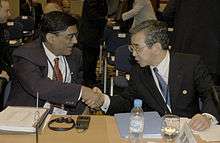Finance Secretary
The Finance Secretary is the Permanent Secretary-level civil servant, who plays a leadership role in the bureaucracy of the Finance Ministry, Government of India.[1]
Ashok Lavasa is current Finance Secretary who replaced Ratan Watal.[2]
Overview

The Ministry of Finance is composed of five departments the Department of Economic Affairs, the Department of Revenue, the Department of Expenditure, the Department of Financial Services and Department of Investment and Public Asset Management (formerly known as Department of Disinvestment). Each of the departments is headed by a secretary. Each of the five secretaries directly reports to the finance minister.
The "Finance Secretary" (FS) is a tag given to one of the five secretaries. It only denotes a first among equals. The other four secretaries do not report to the FS; their files do not flow through him.
By default, the FS tends to be the senior most of the five, where seniority is defined by the year of entry into the civil service and not age. Sometimes, none of the five is labelled FS.
Most finance secretaries have been members of the Indian Administrative Service or IAS, but some of them have been career economists. The last finance secretary of India was Mr. Rajiv Mehrishi, an IAS officer of the Rajasthan Cadre. Montek Singh Ahluwalia, Duvvuri Subba Rao, Bimal Jalan , Manmohan Singh , K. G. Ambegaokar , S Venkitaramanan,and Vijay Kelkar are some of the best known finance secretaries.
Edmund James Sinkinson BCS LLD born Kendal, UK, 16 July 1849, was Financial Secretary to the Government of India. He died at Darjeeling 1 Jan 1891 (see memorial window in Kendal Parish Church).
One Rs note is signed by Finance Secretary of India One Rs note is signed by Finance Secretary of India and it does not have the word i promise to pay the bearer.The Coinage act 2011 which took over Coinage act 1940 says "necessary provisions for inclusion of Government of India one rupee note within the meaning of ‘Coin’ have been consciously incorporated in the Coinage Act, 2011. Further, the RBI, as per Section 24(1) of the RBI Act, 1934, is not empowered to issue bank note of denomination of value of one rupee"
Further, "apart from the metal, the coin may be made of any other material," Hence according to the act One Rupee Note is a 'coin'. Also, in accordance with the RBI Act 1934, RBI can not mint coins.
What are the implications of One Rupee note to be classified as a coin. One Rupee Note is an asset, just like other coins. So "I promise to pay the bearer." is not written on the note. You already hold an asset. While RBI Notes are a liability. One Rupee Note and One Rupee coins are legal tenders for unlimited amounts. One rupee defines the unit of the currency! It is the base of the currency system. A 1000 rupees RBI note says "I promise to pay the bearer the sum on one thousand rupees". Hence RBI notes which are a liability promises to pay you an asset. This asset is defined by "One rupee" So, the Government of India has the power to mint/print 1 Rupee coin/note which are an asset and define the unit of currency. RBI notes get the value from the asset known as 'Rupee'.